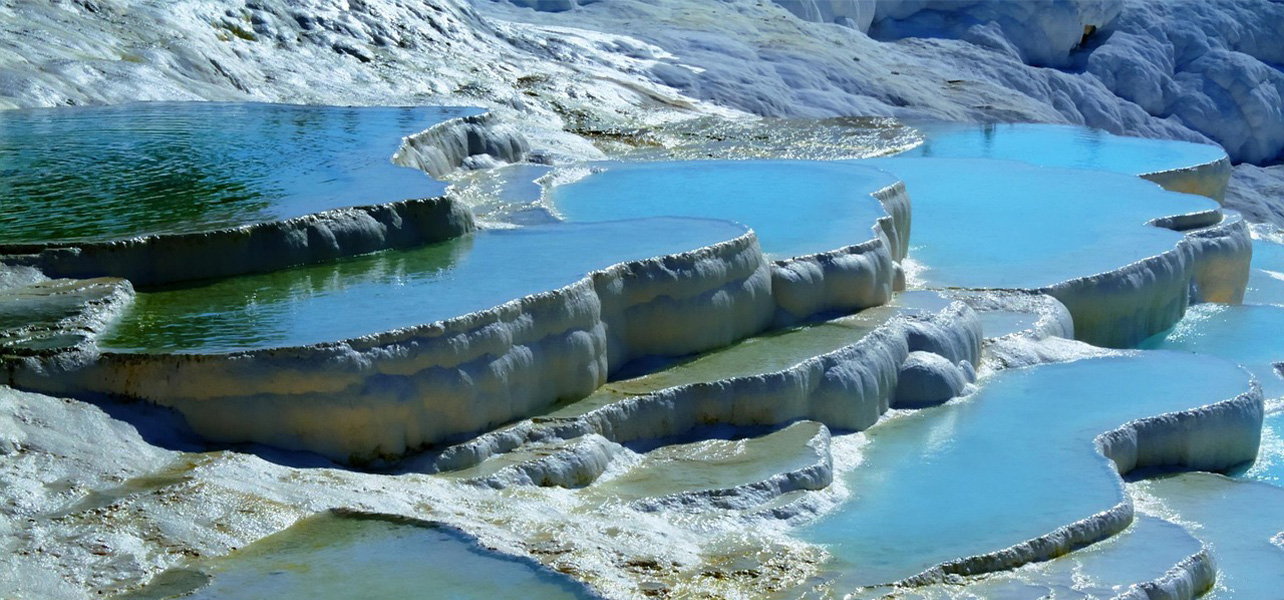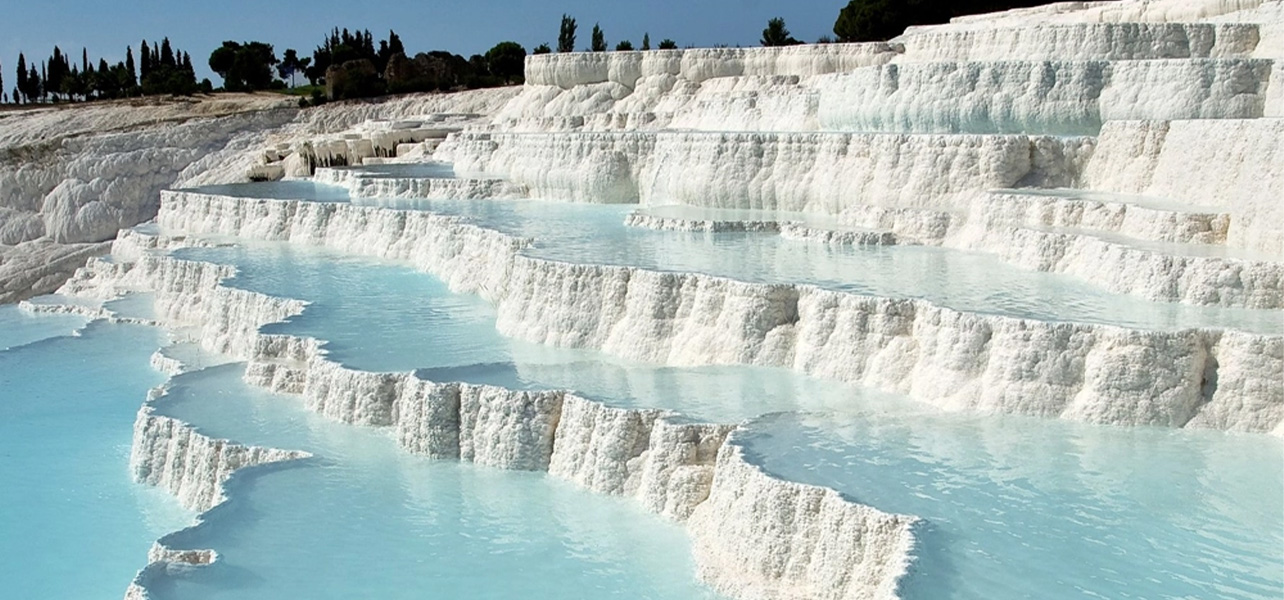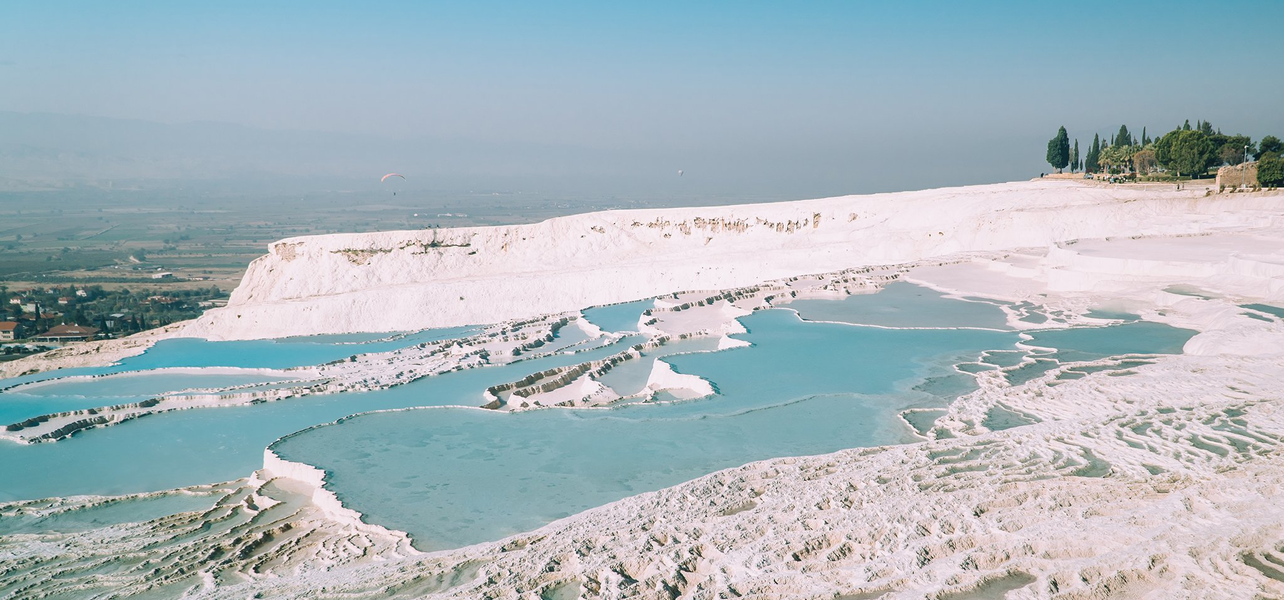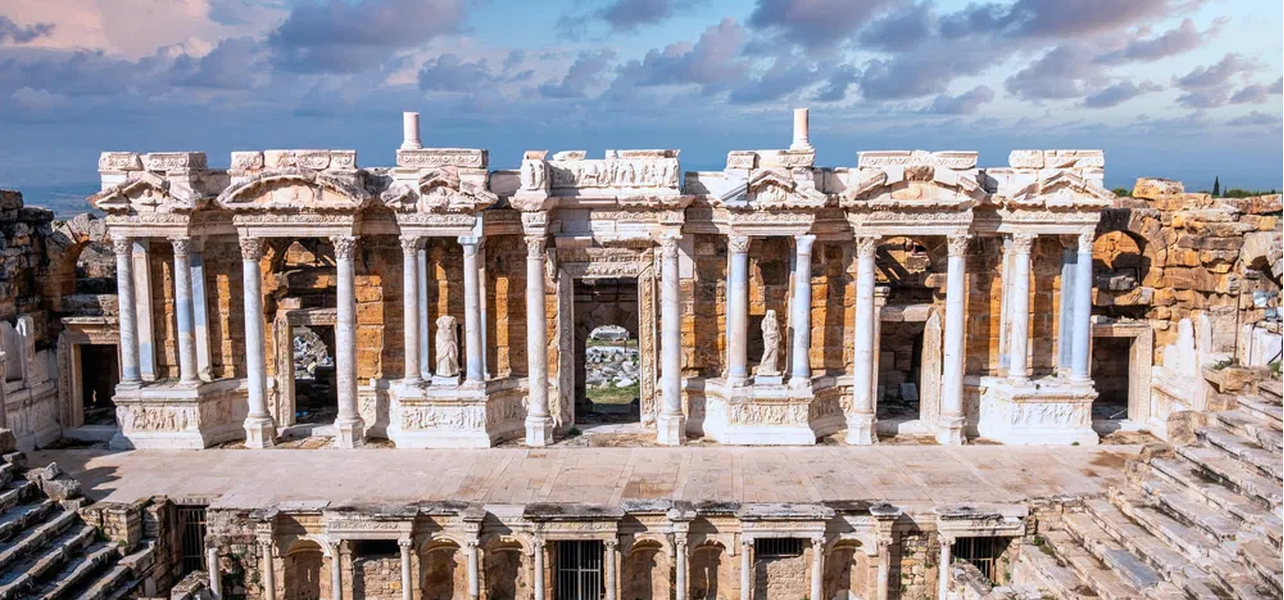Pamukkale Travertines and Hierapolis Ancient City Tour Popular
Rainbow Mountain ValleyVerified
Gallery
Description
Pamukkale: Exploring Turkey's Ethereal White Terraces
Pamukkale, translating to "Cotton Castle" from Turkish, stands as an unparalleled natural attraction within Turkey. Its defining feature is the breathtaking expanse of white travertine terraces that cascade down the hillside, a stunning visual outcome of mineral-rich thermal waters flowing over the plateau for millennia. As these waters cool and their moisture evaporates, they deposit calcium carbonate, gradually sculpting a dreamlike landscape of gleaming white formations and naturally occurring pools. Beyond their captivating appearance, these terraces offer a unique interaction for visitors, who can often wade through the tepid, mineral-laden waters. This experience of walking barefoot on the smooth, calcium deposits while feeling the gentle current of the thermal water is both invigorating and provides a direct connection with this remarkable geological wonder. The continuous interplay of sunlight and shadow across the white surfaces creates a dynamic visual tapestry, ensuring that each visit offers a distinct and memorable perspective. Recognizing the fragility of this unique environment, diligent conservation efforts are in place to safeguard its splendor for generations to come, underscoring the significance of mindful tourism.
Hierapolis: Journeying Through an Ancient City of Healing Springs
Dominating the crest above the radiant white formations of Pamukkale lies Hierapolis, an ancient metropolis of significant historical importance that provides a compelling contrast to the natural beauty below. Established in the 2nd century BC, Hierapolis flourished as a prominent Greco-Roman spa town, drawing individuals from across the ancient world seeking the curative properties of its thermal springs, a tradition that continues to this day. The remarkably well-maintained ruins offer a profound glimpse into the urban design and architectural prowess of antiquity. The awe-inspiring Grand Theater, skillfully carved into the natural contours of the land, stands as a powerful symbol of the city's cultural vibrancy and its capacity for hosting large-scale performances and public gatherings. The sprawling Necropolis, recognized as one of the most extensive and best-preserved ancient burial grounds in Anatolia, stretches for over two kilometers and showcases a diverse array of monumental tombs and sarcophagi, reflecting the city's wealth and the varied origins of its populace. Exploring the vestiges of Roman bathhouses, once vital centers of social and therapeutic activity, the agora (marketplace), and the colonnaded avenues allows visitors to trace the layout of this ancient urban hub and envision the lively atmosphere that once permeated its stone pathways. The presence of significant early Christian structures further highlights Hierapolis's historical role as an important religious center during the early centuries of Christianity. Investigating these ancient remnants offers an invaluable link to the past, enabling a deeper understanding of the social, economic, and spiritual fabric of a civilization that thrived in harmony with the unique natural resources of this land.
Experiencing the Thermal Waters: Cleopatra's Pool and Beyond
An essential component of the Pamukkale and Hierapolis experience is the opportunity to immerse oneself in the therapeutic thermal waters that have attracted visitors for millennia. Among the various thermal springs, Cleopatra’s Pool, also known as the Antique Pool, holds a particularly captivating charm. Legend recounts that this pool was a favored sanctuary of Queen Cleopatra, who was enchanted by its beauty and believed in its restorative properties. Today, visitors can enjoy swimming in this historical thermal spring, surrounded by the submerged remnants of ancient columns and marble fragments, relics of past seismic events that add an element of historical intrigue to the bathing experience. The warm, naturally carbonated water, enriched with minerals, is celebrated for its beneficial effects on the skin and overall well-being. Leisurely floating in this naturally heated pool, amidst ancient artifacts, offers a uniquely tranquil and memorable experience, seamlessly blending relaxation with a touch of historical exploration. Beyond Cleopatra's Pool, the naturally formed pools within the travertine terraces also provide an opportunity to soak in the warm, mineral-rich waters, a practice enjoyed by visitors throughout history seeking both relaxation and potential health benefits. The singular combination of the stunning natural environment and the therapeutic qualities of the thermal waters makes this an indispensable and deeply satisfying aspect of a Pamukkale visit.
Planning Your Visit: Optimal Timing and Practical Advice
While Pamukkale's allure is constant throughout the year, the transitional seasons of spring (April-May) and autumn (September-October) generally present the most agreeable weather conditions for exploring both the natural terraces and the ancient ruins of Hierapolis. During these periods, temperatures are typically mild, making walking and sightseeing comfortable. The summer months (June-August) can bring significant heat, particularly during midday, necessitating adequate sun protection and hydration. Winter (November-March) can be cooler with occasional rainfall, but the site remains accessible and often less crowded. To enhance your visit, consider arriving early in the morning or later in the afternoon to avoid the main tourist influx and to witness the soft, golden light that beautifully illuminates the landscape and the ancient structures. Comfortable walking shoes are paramount due to the varied and sometimes uneven surfaces of both the travertines and the archaeological site. Don't forget sunglasses and a high-SPF sunscreen to protect against the sun's intense reflection off the white calcium deposits. If you intend to swim in Cleopatra’s Pool or other thermal areas, remember to pack your swimwear and a towel. Staying well-hydrated is also important, especially during warmer times of the year. It is crucial to respect the delicate travertine formations by adhering to designated pathways to aid in the preservation of this natural wonder for future generations. By taking these practical considerations into account, you can ensure a more enjoyable and enriching experience at Pamukkale and Hierapolis.
An excursion to Pamukkale and Hierapolis offers a profound and unforgettable journey, seamlessly weaving together the awe-inspiring artistry of the natural world with the rich tapestry of ancient human history. The surreal white terraces of Pamukkale provide a breathtaking and unique backdrop to the remarkably preserved ruins of Hierapolis, a city whose very existence was intertwined with the thermal waters that sculpted the "Cotton Castle." This extraordinary synergy of natural wonder and historical significance creates a multifaceted appeal, drawing visitors with diverse interests. Whether you are captivated by the geological marvel of the travertines, intrigued by the archaeological treasures of a once-thriving Roman city, or seeking the soothing embrace of the thermal waters, Pamukkale and Hierapolis promise an enriching and memorable adventure, leaving you with a deep appreciation for the remarkable cultural and natural heritage of Turkey.
Highlights
Breathtaking
Thermal Wonder
Ancient Marvel
Unforgettable Views
Healing Waters
Itinerary
08:00 – Hotel Pickup
25 May 2025, 04:45 AM
Guests will be picked up from their hotels and begin the journey towards Pamukkale in a comfortable, air-conditioned vehicle.
10:30 – Arrival & Breakfast Break (Optional)
25 May 2025, 04:45 AM
A short stop at a local restaurant where guests can enjoy breakfast (not included) before continuing to Pamukkale.
11:30 – Explore Hierapolis Ancient City
25 May 2025, 04:45 AM
Visit the ruins of the ancient Roman spa city, including its well-preserved theater and necropolis. Learn about the city’s fascinating history from a professional guide.
12:30 – Walk on the Pamukkale Travertines
25 May 2025, 04:45 AM
Experience the dazzling white terraces, formed by mineral-rich thermal waters. Walk barefoot on the warm, healing waters cascading down the terraces.
13:30 – Free Time & Cleopatra’s Pool (Optional)
25 May 2025, 04:45 AM
Guests can swim in the ancient thermal pool where Cleopatra is believed to have bathed. Alternatively, explore the surrounding areas or take stunning photos of the landscape.
14:30 – Lunch at a Local Restaurant
25 May 2025, 04:45 AM
Enjoy a delicious meal featuring traditional Turkish cuisine before heading back.
15:30 – Shopping & Local Delicacies Stop
25 May 2025, 04:45 AM
Visit a local shop where guests can see Pamukkale’s famous textile and onyx stone products.
16:30 – Departure from Pamukkale
25 May 2025, 04:45 AM
Relax on the return journey, taking in the scenic views of the countryside.
19:00 – Arrival Back at the Hotel
25 May 2025, 04:45 AM
Guests will be dropped off at their hotels, concluding the tour with unforgettable memories.
Includes & Excludes
Round-trip transportation from the hotel
Professional English-speaking guide
Entrance fees to Pamukkale and Hierapolis
Visit to the Travertine Terraces
Free time to explore and take photos
Visit to Cleopatra’s Pool (optional, entrance fee not included)
Lunch at a local restaurant
Personal expenses
Entrance fee for Cleopatra’s Pool (if swimming)
Drinks during meals
Tips for the guide and driver
Gallery
Location
Frequently Asked Questions
Yes, visitors can walk on the travertines and feel the thermal waters, but swimming is only allowed in designated areas like Cleopatra’s Pool. An additional entrance fee is required for Cleopatra’s Pool, and it is optional.
It is recommended to bring comfortable walking shoes, sunglasses, a hat, sunscreen, a swimsuit (if you plan to swim in Cleopatra’s Pool), and a towel. Don't forget your camera to capture the stunning views!
 ENG
ENG
 ENG
ENG
 JPN
JPN
 CHI
CHI











